Fintech Research Pt. 2
An experience based study of Bank al Habib’s Digital Account Opening Process.
By Fatima Nooraen
Introduction
ABOUT
This study highlights some of the main pain points that the users face while opening a digital bank account in Bank Al Habib. The insights are presented through a fictional character, Laiba’s journey as she navigates through Bank al Habib’s website to open her Bank Account.
How it all began
One fine day, Team Designist decided to conduct a detailed research on the Online Account Opening processes of six banks and E-wallets. After gathering insights from usability tests, and heuristic analysis, we decided to convey these insights to the world. We hope that our research becomes an inspiration for Designers to engage in Research as a learning practice.
our LIMITATIONS
This research was conducted with limited users, is observational and analytical in nature, and is based on the data gathered from usability tests and heuristic analysis. It focuses only on the user experience of potential customers and does not take business limitations and restrictions into account. This is why some pain points, may not be the responsibility of the bank but a result of other factors that banks may have to comply with, such as State Bank requirements, business restrictions etc.
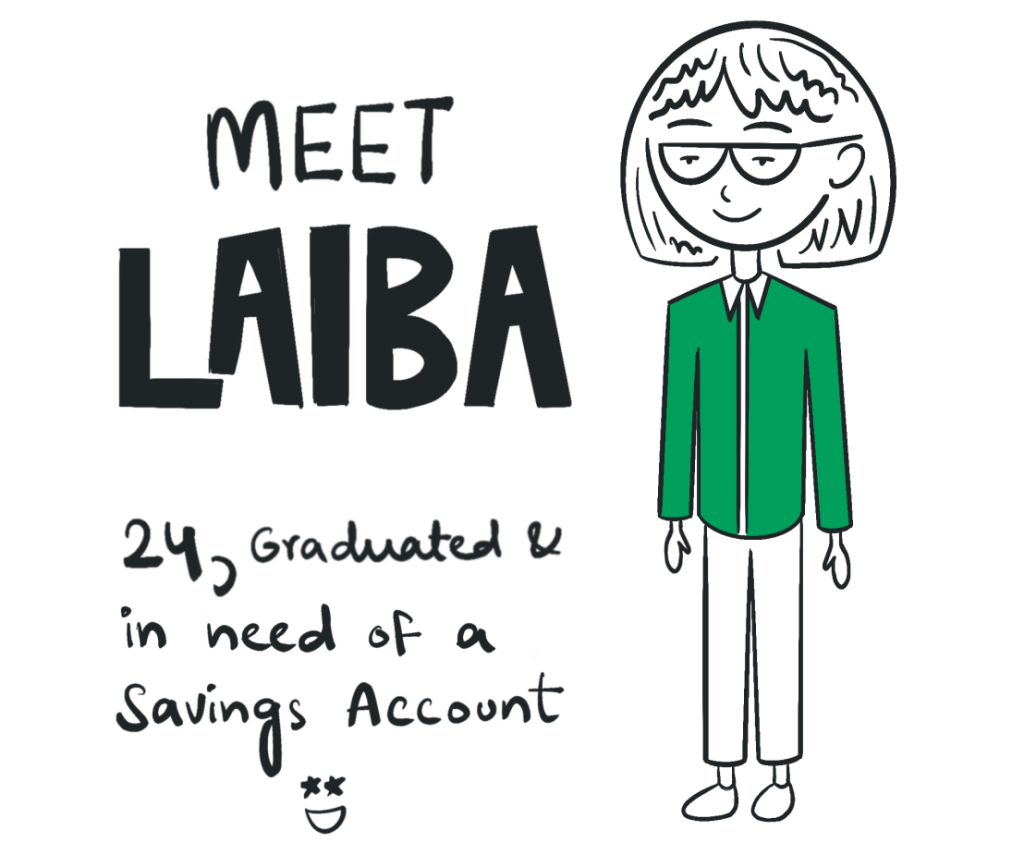
Laiba,
a 24 year old fresh graduate, had
Lpreviously opened a current account in Allied Bank Limited, for her salary disbursement. After a few months of her work, she has realized that its difficult to keep track of her spending and saving with only one bank account.
To manage her savings in a better way, she decides to open a bank account in Bank al Habib, on her colleague’s recommendation.
Lpreviously opened a current account in Allied Bank Limited, for her salary disbursement. After a few months of her work, she has realized that its difficult to keep track of her spending and saving with only one bank account.
To manage her savings in a better way, she decides to open a bank account in Bank al Habib, on her colleague’s recommendation.
1. Getting Started with BAHL
Laiba gets started with Bank Al Habib’s account opening process, by visiting their website. Due to a cramped view, she finds it difficult to read the instructions. Though due to the shortage of time, she decides to move forward and figure out the steps ahead in the application.

2. OTP or OTAC?
When Laiba reaches the OTP screen, she does not read all of the text since OTP is a normal thing for her. She inputs the number she receives on her phone but finds that it's incorrect.
The error indicates that she has input an invalid OTP.
After rechecking the number and staying confused for 2 minutes, she reads the text and realizes that the OTP and the OTAC function differently.
The error indicates that she has input an invalid OTP.
After rechecking the number and staying confused for 2 minutes, she reads the text and realizes that the OTP and the OTAC function differently.
Important information should be easy readable and visible
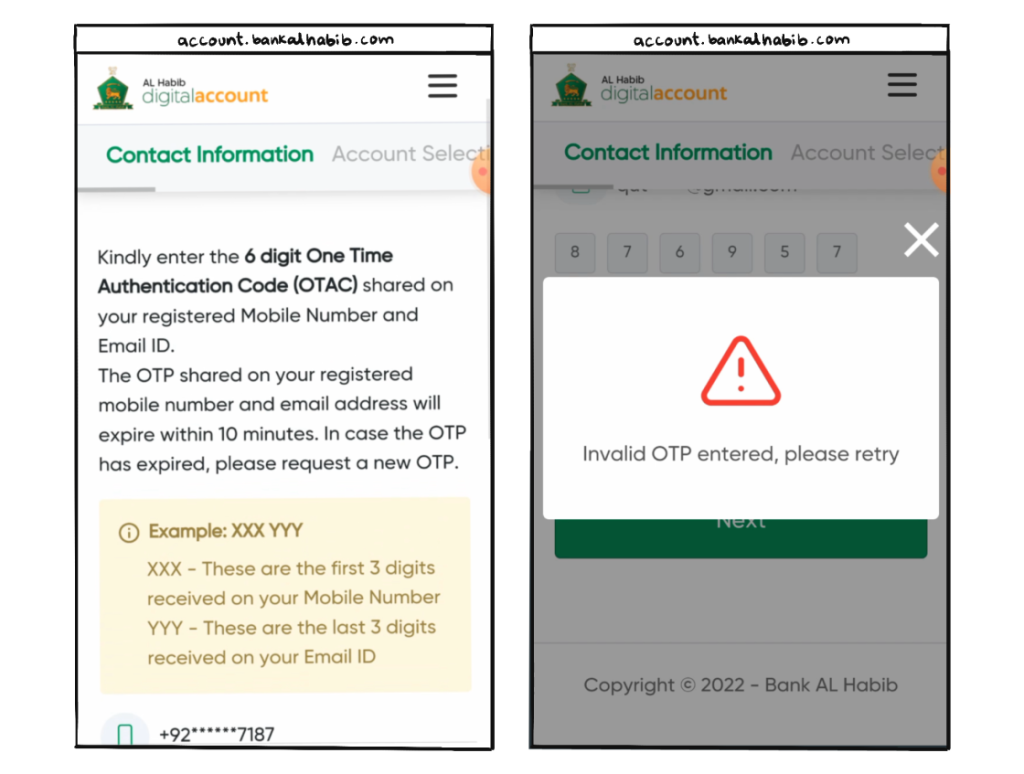
3. Branch Selection
Laiba catches herself off-guard, when she is told that Bank al Habib wants to use her location. She blocks the request as a reflex since the reason to use her location was not being indicated in the popup shown.
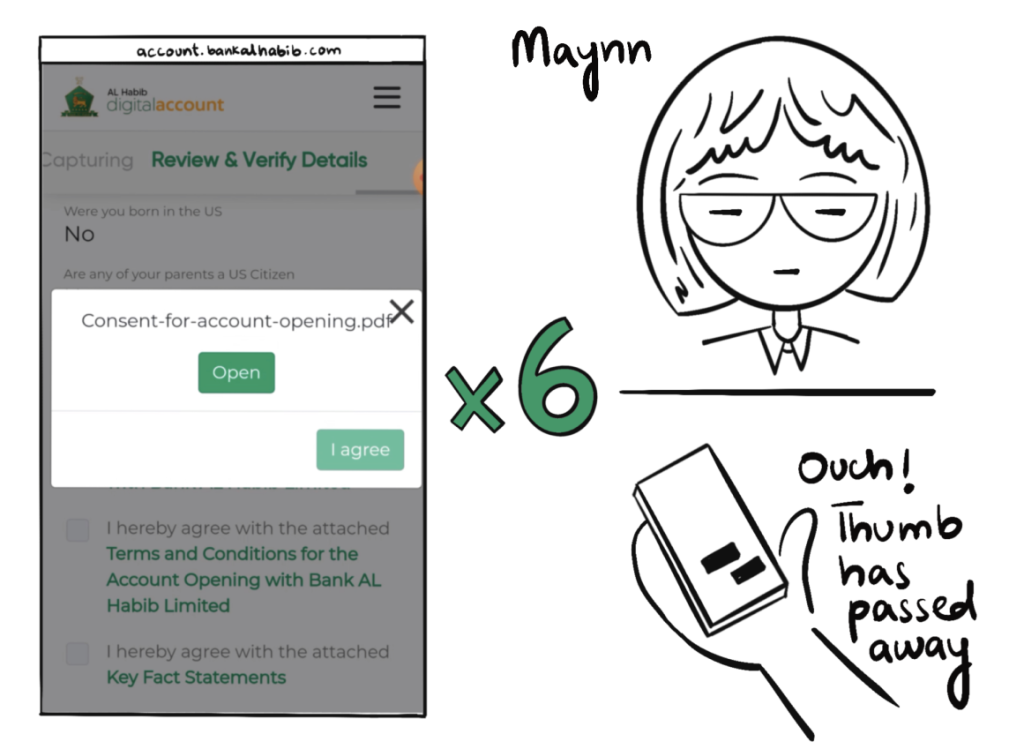
4. Locating Nearest Branch
After the popup is closed, she realizes the location was needed for branch selection. She clicks on “Locate nearest branch”, expecting to see the popup again, but is instead greeted by a vague error .
Without thinking too much, Laiba selects a branch manually and moves forward.
Without thinking too much, Laiba selects a branch manually and moves forward.
Well designed Errors indicate exactly and simply what the problem is, and guide the user how to overcome it
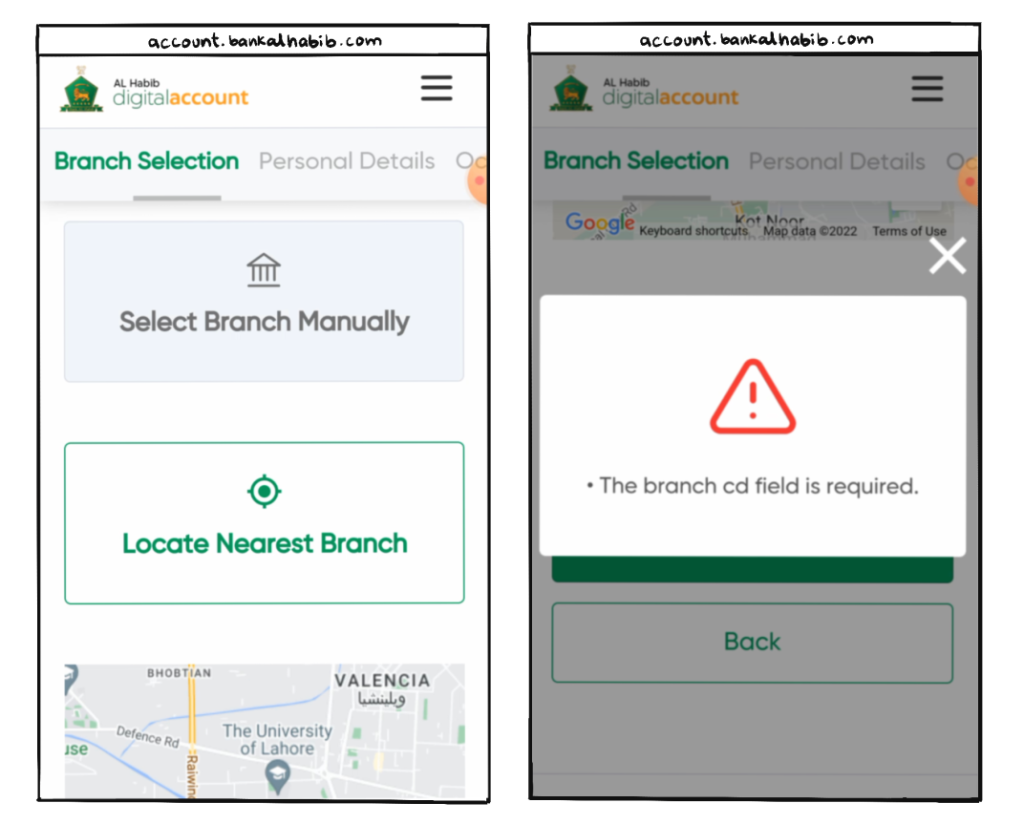
5. Capturing Live Photo
Yay, its finally time for laiba to upload her documents and capture her live photo.
Laiba is again taken aback when the chrome asks for her microphone to be accessed stating that it wants to record audio. Disappointed and confused, Laiba denies the request and moves forward, uploads her signature, a picture and the rest of the documents.
Laiba is again taken aback when the chrome asks for her microphone to be accessed stating that it wants to record audio. Disappointed and confused, Laiba denies the request and moves forward, uploads her signature, a picture and the rest of the documents.
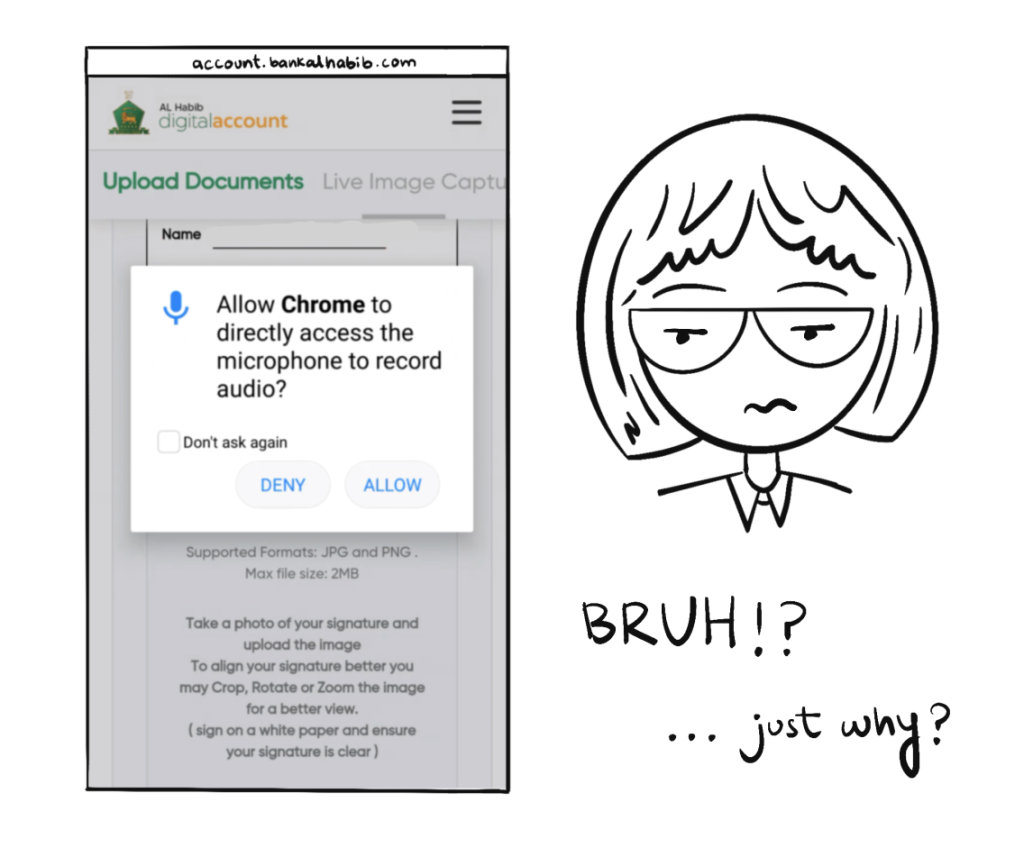
6. Address Details
After filling in her address details, Laiba tries to move forward but is met with a vague error again, asking her to add her address. She refills the information and tries to move forward, only to face the same issue again.
She clicks on “Add Address to” see if new input fields are to be filled and realizes that thats how the address she just filled is saved. The plus icon and the words “Add Address” though indicated as if its to add a second address.
She clicks on “Add Address to” see if new input fields are to be filled and realizes that thats how the address she just filled is saved. The plus icon and the words “Add Address” though indicated as if its to add a second address.
Visual cues and Icons, if used in the right context can help users identify what they need to do without any confusion

7. Terms of Agreement
After completing the whole process, when Laiba reaches the final step, she expects to review the application once and get done after checking a few boxes.
What she didn’t expect (and what happens) is that she gets 6 different popups where she has to open a pdf and then close it and press I agree.
Multiple and continuous taps felt quite painful to Laiba, both literally and metaphorically.
What she didn’t expect (and what happens) is that she gets 6 different popups where she has to open a pdf and then close it and press I agree.
Multiple and continuous taps felt quite painful to Laiba, both literally and metaphorically.

8. Woohoo Done!
At this point, Laiba expected another unexpected step but instead gets overwhelmed with joy when she sees that she’s finally done with the process.
She closes the website and patiently waits for any kind of correspondence from the bank.
She closes the website and patiently waits for any kind of correspondence from the bank.
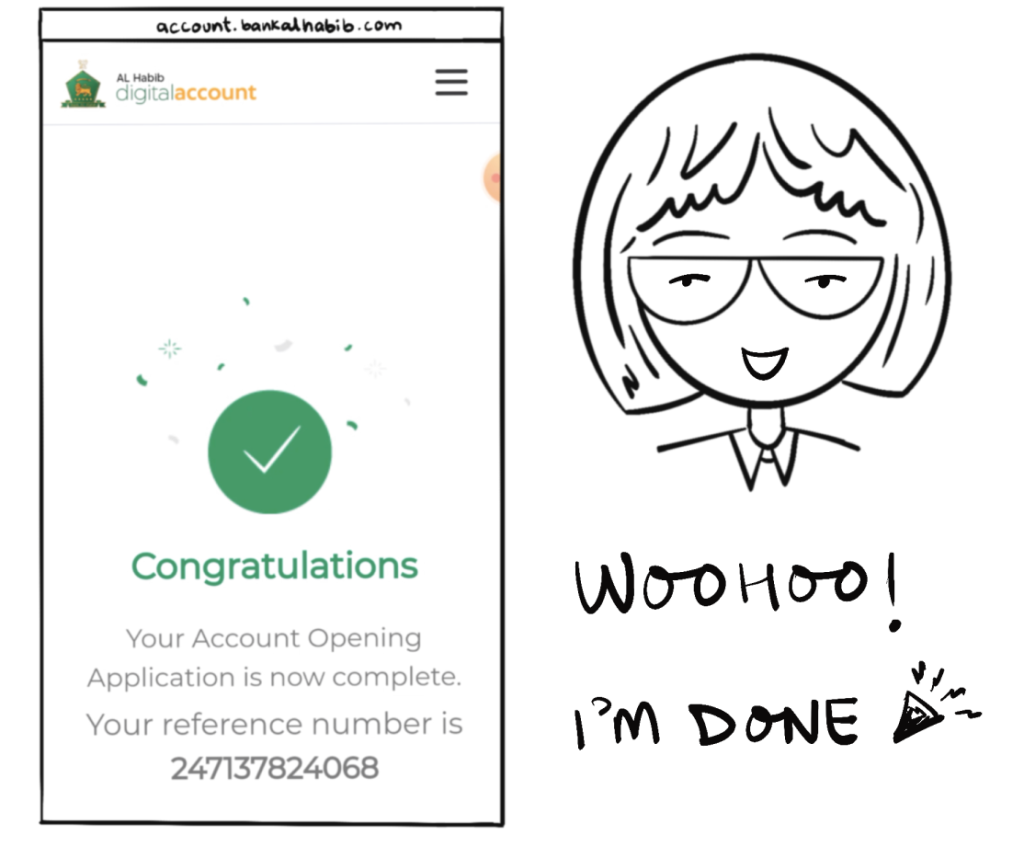
9. One last Step...
Laiba is thrilled when she sees that Bank al Habib is calling her after only a few minutes have passed.
Upon picking up, she is told that she needs to submit her utility bills by email to prove her permanent residency. She wonders why they didn't ask in the online application itself.
Without further ado, she submits the documents and waits for the bank account to be opened soon.
Note: After many attempts, a prolonged process, and due to the miscommunication with the Bank, regarding the submission of documents, the account did not get opened as expected.
Upon picking up, she is told that she needs to submit her utility bills by email to prove her permanent residency. She wonders why they didn't ask in the online application itself.
Without further ado, she submits the documents and waits for the bank account to be opened soon.
Note: After many attempts, a prolonged process, and due to the miscommunication with the Bank, regarding the submission of documents, the account did not get opened as expected.

I'm subtitle
Final Thoughts
Though Laiba is a fictional character, her journey with Bank al Habib’s account opening process is based on a cumulative experience of real users.
Overall, we noted that the most consistent issue in Bank al Habib’s digital account opening process is that it is unable to present information in a digestable and easy manner. We think this problem can be catered to if aspects like UX Writing, Iconography and Errors are improved throughout the process.
Bank Account Opening, is an already intimidating process which is why important information if not available readily and easily, significantly impacts the whole process.
We believe that Bank Al Habib can greatly improve the experience of opening a digital bank account, if they cater to these main issues.
Overall, we noted that the most consistent issue in Bank al Habib’s digital account opening process is that it is unable to present information in a digestable and easy manner. We think this problem can be catered to if aspects like UX Writing, Iconography and Errors are improved throughout the process.
Bank Account Opening, is an already intimidating process which is why important information if not available readily and easily, significantly impacts the whole process.
We believe that Bank Al Habib can greatly improve the experience of opening a digital bank account, if they cater to these main issues.
Upcoming Studies
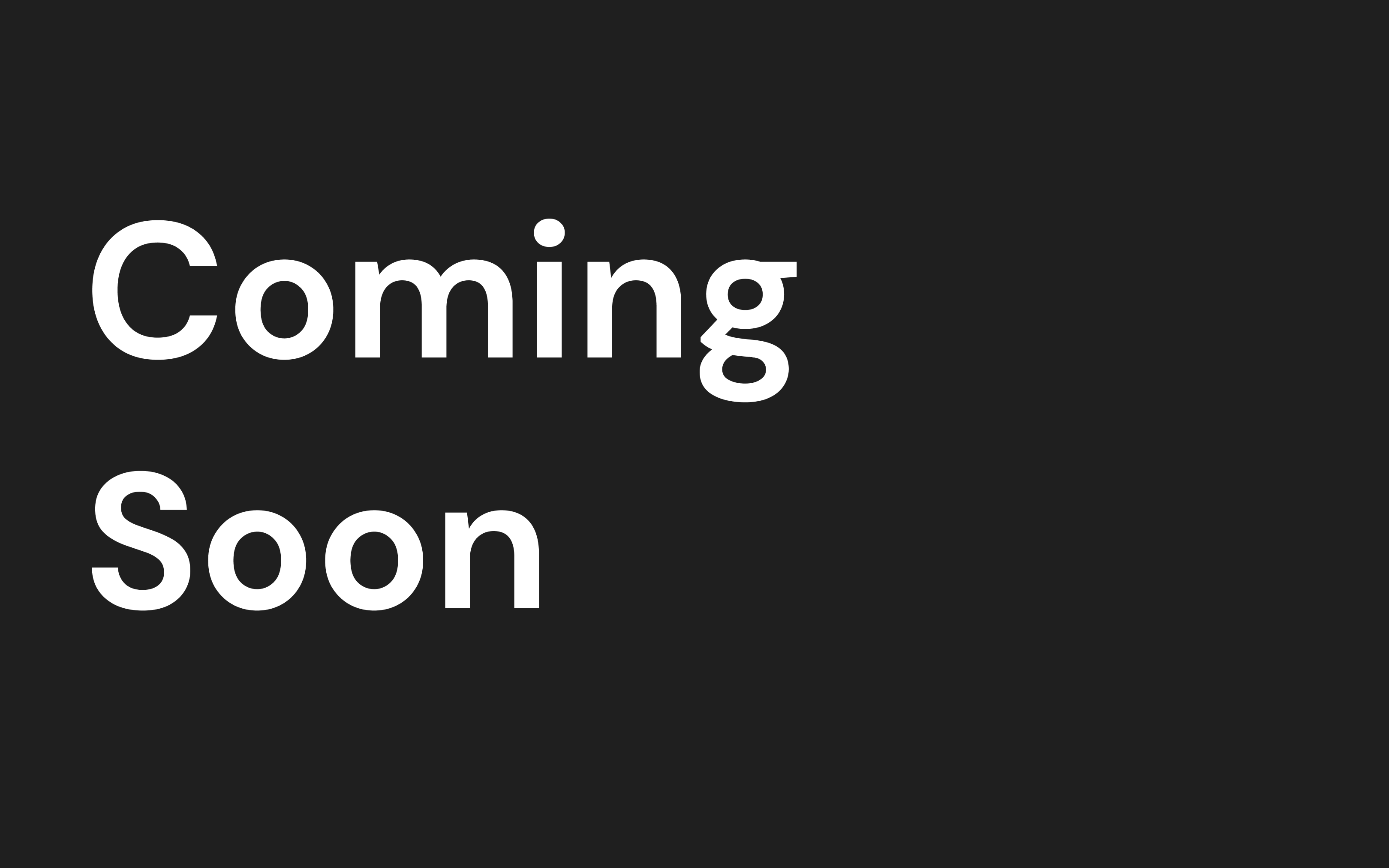
Jazz Cash E-Wallet: Account Opening Experience

